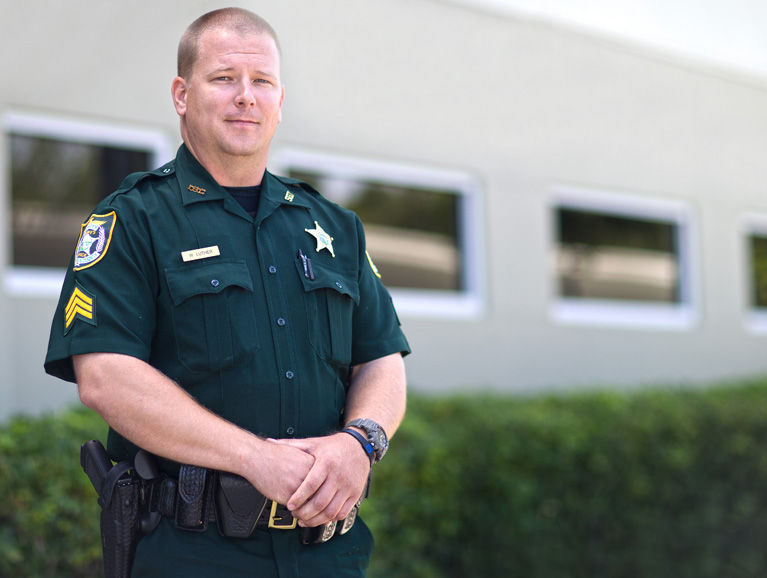
The weather is hot, but that tennis match is still on. When you love to play golf as much as you do, giving the clubs a rest is not an option. Taking a nice long run or walk on the beach is hard to forgo when the ocean is so beautiful. And the lawn still needs to be cut and plants pruned, no matter what the weather has to offer.
The relentless and intense heat of Florida is not ideal for many outdoor activities this time of year, and heat exhaustion and heat stroke can set in. But there are ways to keep playing your favorite sports and doing your chores despite it all.
The key, says Dr. Barry Garcia, sports medicine doctor who practices at Vero Orthopedics and Vero Neurology, is to be prepared, smart and take action to avoid becoming dangerously overheated.
Garcia, who serves as medical director of the Indian River County SWAT, says it is easy to underestimate the risks because there is much more to consider besides the temperature. Among the factors: radiation of the sun off of the asphalt, wind flow, heat index. It’s obviously cooler under a tree or on grass than on unshaded cement, but the obvious can be overlooked in the midst of activity.
“Looking at the weather purely in terms of temperature is oversimplifying,” said Garcia. “It matters if you acclimate to heat, if you are predisposed to illness, if you are dehydrated, if you are taking medications, if your sleep and activity pattern is regular or not.”
Heat exhaustion is a condition whose symptoms may include heavy sweating and a rapid pulse, a result of your body overheating. It’s one of three heat-related syndromes, with heat cramps being the mildest and heatstroke being the most severe.
Causes of heat exhaustion include exposure to high temperatures, particularly when combined with high humidity, and strenuous physical activity. Without prompt treatment, heat exhaustion can lead to heat stroke, a life-threatening condition. Fortunately, heat exhaustion is usually preventable.
Heat cramps are painful, involuntary muscle spasms that occur during heavy exercise in hot environments. You’re most likely to get heat cramps in the calf, arm, abdomen and back.
Heat can be a killer, and is thought to have contributed to the death of a 14-year-old freshman at Sebastian River High School, who during a football training camp at Camp Blanding last month complained of dizziness and nausea.
According to reports, a call came in from a coach who told the 911 operator, “I got a football player at the camp who suffered from heat issues … We’ve got water on him trying to cool him off.” The boy vomited and was lethargic and unresponsive by the time an emergency rescue team arrived at the practice field, the report said. The teenager was transported to Shands Starke Regional Medical Center and died.
In light of the tragedy, Garcia felt it was important for people to learn about the dangers of overheating.
September is not much better than August in terms of heat. Daily high temperatures are around 88°F throughout the month, exceeding 91°F or dropping below 83°F only one day in 10 on average.
“Heat in summer is a big deal,” said Dr. John Fernandez, emergency medicine doctor at Sebastian River Medical Center. “People can get very ill.”
The hard cold facts speak for themselves. Some 7,000 people die in the U.S. each year from heat stroke, according to the American College of Emergency Physicians. It is the second leading cause of death for athletes in this country. The mortality rate is 50 to 75 percent of patients; 80 percent of those are over 50.
There have been 13 heat-related calls since May 1, according to Indian River County Fire and Rescue.
Fernandez has seen it over and over. Victims range from “young workers who are outdoors doing lawn maintenance to older people who are homebound whose air conditioning may go out.”
Once a person’s core temperature exceeds 104 degrees, the body goes backwards in its ability to radiate heat; sweating will stop.
Telltale signs include dehydration, which makes you more susceptible to heat exhaustion and heat stroke. You can develop these without realizing it – often, thirst isn’t felt until after you are under-hydrated.
“You have to be smart, have to be cognizant of dehydration, temperature and humidity,” Garcia says.
Signs and symptoms of heat exhaustion often begin suddenly, sometimes after excessive exercise, heavy perspiration and inadequate fluid or salt intake. They resemble those of shock and may include feeling faint, dizzy or nauseous; heavy sweating; a rapid, weak heartbeat; low blood pressure; cool, moist, pale skin; low-grade fever; heat cramps; headache; fatigue; dark-colored urine.
Defenses include keeping your body temperature cool by avoiding direct sunlight, staying in air conditioning, wearing lightweight, light-colored clothing, and taking cool showers or baths. If outside, also drink water at least every hour and avoid alcohol and sugary drinks.
If you suspect someone has heat exhaustion, get the person out of the sun and into a shady or air-conditioned location, lay the person down and elevate the legs and feet slightly, loosen clothing, have the victim drink cool water or another beverage without alcohol or caffeine, spray or sponge with cool water and fanning, and monitor the person carefully.
The hazard of excessive heat is familiar to Sgt. William Luther of the Indian River County Sheriff’s Department.
“I’ve been to numerous calls where people have had heat exhaustion, even had deaths,” he said. “A man was mowing the lawn with a push mower; another man was pressure-washing his house in 98 degree weather.”
As a former SWAT team member, Luther, 34, has had to be conscious of warding off heat problems while training. “There were a couple of times I thought I was going to go out,” he said. “It’s a weird feeling, almost a bit like vertigo, where you lose a sense of reality.”



